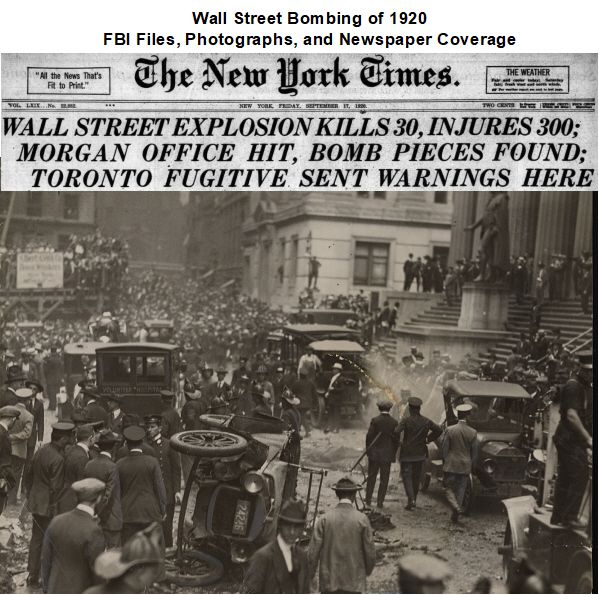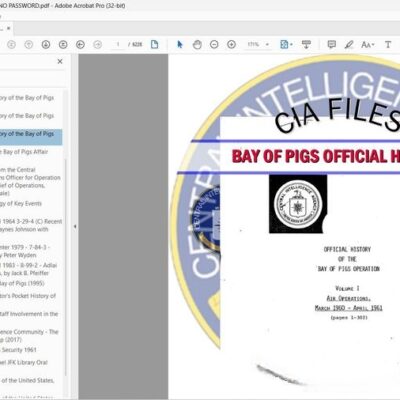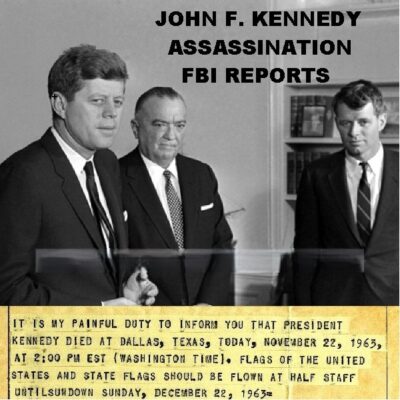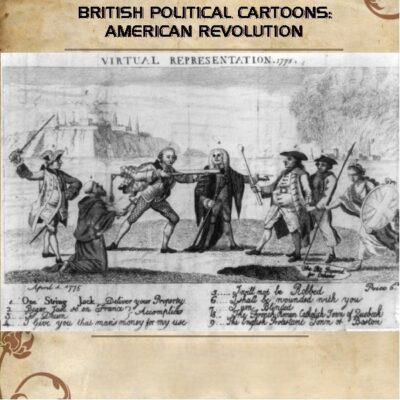
Wall Street Bombing of 1920 – FBI Files, Photographs, and Newspaper Coverage
$19.50
Description
Wall Street Bombing of 1920: A Timeline and Cast
Prior to September 16, 1920:
- 1914-1919: A series of bombings attributed to the Galleanists (followers of Luigi Galleani) occur across the United States.
- Previous Year (1919): Two bombing campaigns fomented by Italian anarchists, using similar flyers to those found on Wall Street, take place.
- Unknown Date (Pre-Sept 16, 1920): A letter carrier finds four crudely spelled and printed flyers from a group calling itself the “American Anarchist Fighters” near Wall Street. These flyers demand the release of political prisoners.
- Unknown Date (Pre-Sept 16, 1920): Tennis champion Edwin Fischer sends warning postcards to friends, advising them to leave the Wall Street area before September 16, claiming to have received the information “through the air.”
September 16, 1920:
- Around Noon: A man driving a horse-drawn carriage stops in front of the United States Assay Office, across the street from the J. P. Morgan building on Wall Street.
- Minutes Later: The driver exits the carriage and quickly disappears into the crowd.
- Immediately After Driver Disappears: The cart explodes into a hail of metal fragments, killing more than 30 people and injuring approximately 300.
- Immediately After Explosion: The New York City Police and Fire Departments, the Bureau of Investigation (BOI), and the U.S. Secret Service begin their investigations.
- September 16, 1920 – Ongoing: Nationwide newspapers begin covering the bombing, with initial reports appearing on this date.
September 17, 1920:
- The Bureau of Investigation (BOI) formally begins its investigation into the bombing, with files dating from this day.
- The New York Times publishes its complete day-after coverage of the bombing.
October 1920:
- Investigators are able to locate the blacksmith who shod the horse used in the bombing, but he provides little useful information.
After September 1920 – January 1924:
- Ongoing Investigation: The BOI interviews hundreds of people, but gathers little valuable information.
- Investigation Challenges: The few recollections of the driver and wagon are vague. Investigators are unable to locate the stable where the horse was newly shod. None of the victims are identified as the driver of the wagon.
- Bomb Reconstruction: The NYPD successfully reconstructs the bomb and its fuse mechanism, but debates continue about the nature of the explosive, as components were commonly available.
- Flyer Investigation: The BOI attempts to trace the printing of the “American Anarchist Fighters” flyers, without success.
- Suspect Focus: The BOI’s investigation primarily targets anarchists, communists, trade unionists, and members of the Galleanist group, due to previous bombing campaigns and their ideology of “heroic violence.”
- Luigi Galleani Suspected: Based on previous attacks, the BOI initially suspects followers of the Italian Anarchist Luigi Galleani, but the case cannot be proved, as Galleani had fled the country.
- Edwin Fischer Interviewed: The BOI agents question tennis champion Edwin Fischer about his pre-bombing warnings. They discover he regularly issued such warnings and he is committed to Amityville Asylum, diagnosed as insane but harmless.
- Arrests and Lack of Evidence: The BOI and local police investigations lead to occasional arrests, but no evidence supports any indictments. The case is never officially declared solved.
November 1, 1921:
- The New York City Police Department releases its 429-page Annual Report for 1920. This report mentions the September 16, 1920 bombing and emphasizes the need for constant surveillance of anarchists, Bolshevists, and other “radicals,” as well as the necessity for a special squad and secret police to anticipate and prevent similar attacks.
January 29, 1927:
- Newspaper coverage related to the bombing continues up to this date, as indicated by the collection of nationwide newspapers.
Cast of Characters
Principle People Mentioned:
- Luigi Galleani: An Italian anarchist whose followers, known as Galleanists (or Galleanisti), were suspected by the Bureau of Investigation (BOI) of being responsible for the Wall Street bombing. He professed a message of “heroic violence in the face of capitalist oppression” and was believed to have been involved in a series of bombings between 1914 and 1919. He had fled the country by the time of the 1920 bombing.
- Edwin Fischer: A tennis champion who sent warning postcards to friends, telling them to leave the Wall Street area before September 16, 1920. He claimed to have received this information “through the air.” Investigators found he regularly issued such warnings and he was subsequently committed to Amityville Asylum, where he was diagnosed as insane but harmless.
- The Driver (Unidentified): The man who drove the horse-drawn carriage to Wall Street on September 16, 1920, parked it in front of the U.S. Assay Office, and disappeared moments before the explosion. His identity remains unknown, and vague recollections of him provided little investigative value.
- The Letter Carrier (Unidentified): The individual who found four crudely spelled and printed flyers from the “American Anarchist Fighters” group in the Wall Street area prior to the bombing. These flyers demanded the release of political prisoners.
- The Blacksmith (Unidentified): The individual who shod the horse used in the bombing. He was located by investigators in October 1920 but could not offer much information.
Groups/Organizations Mentioned:
- American Anarchist Fighters: The name of the group that claimed responsibility for the bombing via crudely printed flyers found near the scene. Their identity and connection to the bombing were never confirmed.
- Galleanists (Galleanisti): Followers of Luigi Galleani, an Italian anarchist. This group was the primary suspect of the Bureau of Investigation due to their history of bombings between 1914 and 1919 and their advocacy of violent action against capitalism.
- New York City Police Department (NYPD): One of the primary law enforcement agencies that investigated the Wall Street bombing. Their 1920 Annual Report highlighted the event and emphasized the need for surveillance of radicals and the establishment of a “secret police” to prevent future attacks.
- Bureau of Investigation (BOI): The predecessor to the Federal Bureau of Investigation (FBI). The BOI led the federal investigation into the Wall Street bombing, collecting thousands of pages of files. Despite extensive efforts, they were unable to conclusively identify the bombers.
- U.S. Secret Service: One of the federal agencies involved in the immediate aftermath and investigation of the bombing.
Wall Street Bombing of 1920 – FBI Files, Photographs, and Newspaper Coverage
2,844 pages of FBI files, photographs, and newspaper coverage of the September 16, 1920, bombing of Wall Street in New York City.
At about noon on September 16, 1920, a man driving a horse driven carriage stopped in front of the United States Assay Office, across the street from the J. P. Morgan building in the heart of Wall Street. The driver got down and quickly disappeared into the crowd.
Within minutes, the cart exploded into a hail of metal fragments, killing more than 30 people and injuring some 300.
Immediately the New York City Police and Fire Departments, the Bureau of Investigation, and the U.S. Secret Service began their investigations. The Bureau of Investigation, the predecessor of the Federal Bureau of Investigation, interviewed hundreds of people who had been around the area before, during, and after the attack, but developed little information of value. The few recollections of the driver and wagon were vague and virtually useless. The NYPD was able to reconstruct the bomb and its fuse mechanism, but there was much debate about the nature of the explosive, and all the potential components were commonly available.
The most promising lead had come prior to the explosion. A letter carrier had found four crudely spelled and printed flyers in the area, from a group calling itself the “American Anarchist Fighters” that demanded the release of political prisoners. The letters seemed similar to ones used the previous year in two bombing campaigns fomented by Italian anarchists. The Bureau attempted to trace the printing of these flyers, without success.
Based on bomb attacks over the previous decade, the Bureau initially suspected followers of the Italian Anarchist Luigi Galleani. But the case couldn’t be proved, and the anarchist had fled the country. In the end, the bombers were not identified. The best evidence and analysis since suggest that the Bureau’s initial thought was correct, that a small group of Italian anarchists were to blame. But the case has never been declared solved.
(Sources: Federal Bureau of Investigation. and The Hunt for the Red Scare Terrorist Bombers by Charles H. McCormick)
Content in this collection includes:
FBI Files
2,133 pages of United States Justice Department’s Bureau of Investigation (BOI, the forerunner of the Federal Bureau of Investigation) files dating from September 17, 1920, to January 1924.
Files show that the BOI investigation began to stall when none of the victims turned out to be the driver of the wagon. The remains of the horse showed it was newly shod, however, investigators could not locate the stable where the work was performed. Investigators were able to find the blacksmith in October 1920, but he could not offer much information.
Bureau agents questioned tennis champion Edwin Fischer, who had sent warning postcards to friends, telling them to leave the area before September 16. He told police he had received the information “through the air”. They found that Fischer made a regular habit of issuing such warnings, and had him committed to Amityville Asylum, where he was diagnosed as insane but harmless.
The BOI and local police investigation lead to occasional arrests, but in time no evidence supported any indictments.
The targets of most of the investigation were anarchists, communists, trade unionists, and members of the Galleanist group. The Galleanists, also called the Galleanisti, were followers of the anarchist Luigi Galleani. Galleani professed a message of heroic violence in the face of capitalist oppression. The Galleanists were believed to have been involved in a series of bombings that occurred between 1914 and 1919.
NYPD 1920 Annual Report
The 429-page Annual Report of the New York City Police Department for the year 1920, released on November 1, 1921. Mention is made of the September 16, 1920 bombing and separately repeated mention is made of the need to surveille anarchists, Bolshevists, and other “radicals.”
From the report, “The dangerous anarchistic elements have been under constant surveillance during the present administration, and in order to ensure that their movements and possible projects should receive adequate attention, a special squad was organized, and its services virtually devoted to them.”
The report cites the need for secret police, stating, “During the next few years, at least this City will be the port of entry for many tens of thousands of immigrants, from all parts of Europe. Among them are bound to be a large percentage of malcontents, agitators, and virulent anarchists, thirsting for sensationalism and violence to shore up their insane propaganda and wicked doctrine, and to gain recruits and money through terrorism, and the perpetration of just such outrages as the explosion in Wall Street. Under our present laws, the only way that such holocausts can be prevented is to anticipate them through the medium of espionage, to be followed by prompt and drastic police action and a special body of men must be recruited and intensively schooled for this particular purpose, and none other.”
Newspapers
The New York Times September 17, 1920
The entire issue of the September 17, 1920, New York Times with complete day after coverage of the bombing.
Newspapers – Nationwide
219 pages of full sheet newspaper pages from across the country, dating from September 16, 1920, to January 29, 1927, with news related to the bombing. The newspapers include:
New York Tribune (New York, NY)
The Sun and New York Herald (New York, NY)
The Evening World (New York, NY)
The Daily Worker (New York, NY)
Perth Amboy Evening News (Perth Amboy, NJ)
Evening Public Ledger (Philadelphia, PA)
Washington Herald (Washington D.C.)
The Evening Star (Washington D.C.)
The Washington Times (Washington D.C)
The Bridgeport Times (Bridgeport, CT)
The Alaska Daily Empire (Juneau, AK)
Indiana Daily Times (Indianapolis, IN)
The Birmingham Age-Herald (Birmingham, AL)
Chickasha Dally Express (Chickasha, OK)
Alexandria Gazette (Alexandria, VA)
New Britain Herald (New Britain, CT)
Daily Star Mirror (Moscow, ID)
The Caledonian-Record (St. Johnsbury, VT)
Carson City Daily Appeal (Carson City, NV)
The Chattanooga News (Chattanooga, TN)
The Bismarck Tribune (Bismarck, ND)
Great Falls Daily Tribune (Great Falls, MT)
The Arizona Republican (Phoenix, AZ)
Albuquerque Morning Journal (Albuquerque, NM)
Tulsa Daily World (Tulsa, OK)
Photographs
31 news service photographs of the aftermath of the bombing from the Bain News Service, New York Worid-Tetegram and the Sun Newspaper Photograph Collection, and Underwood & Underwood.



